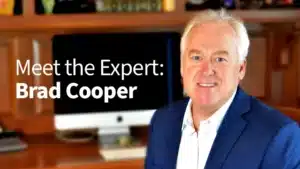
A new expert has joined Enea’s ranks! Our latest edition to the team, Brad Cooper, is not to be confused with the Hollywood star, though he is well respected in industry circles. Brad joins us as Head of Threat Intelligence for The Americas, with over 20 years of experience in signaling and messaging security. We sat down with Brad to learn more about his background and get his expert opinion on the threat landscape that exists for operators and regulators.
We started off the conversation by delving into Brad’s background and experience.
Hi Brad, can you tell us more about your background and experience? How did you begin your career in telecoms?
My undergraduate work was in Telecommunications at Michigan State University. Essentially, my studies focused on the technology, economics, and regulations around public telephone networks. Interestingly enough, some of my independent study was with Common Channel Signaling and SS7, where I got my first look inside the actual protocols utilized in commercial networks. This work demystified the technology and prepared me well for what was to come in mobile networking because of its heavy dependence on signaling to function.
How did you become interested in cybersecurity?
My background is in building and maintaining infrastructure and core applications that comprise the commercial mobile and fixed telco networks. Along the way, I focused heavily on Messaging and Roaming. Early on I had to address security matters such as mobile phone cloning, roaming fraud, and toll fraud. I really enjoyed working internally and with others in the industry to battle security matters in creative ways before industry standards caught up. For instance, RF Fingerprinting was a technology that was applied to combat cloning prior to the introduction of cellular authentication. It wasn’t really until I became involved with bona fide security forums and associations that I realized that cybersecurity was a big part of my job. I view my contributions to reducing messaging abuse and containing signaling threats the most rewarding aspects of my career.
How has your career evolved since then?
My career growth parallels the growth of mobile communications, where I learned new things with every generation of wireless. I was fortunate enough to work for companies that encouraged me to learn new aspects of the business and allowed me to take on Engineering, Operations and Planning roles. Throughout my career, I was encouraged to take on more leadership responsibility, which I found incredibly rewarding.
Can you comment on the current threat landscape? How is it evolving?
Initially, mobile messaging was mainly peer-to-peer communication with limited exceptions and far fewer threats. The mobile messaging ecosystem is morphing into a more accessible medium where more application or A2P senders are entering the ecosystem to reach mobile users with commercial and other types of messages. With the growth in accessibility to the mobile messaging ecosystem and the increasing complexity with those new players, the number of potential threats rises.
Aside from the above, Artificial Intelligence will be a major decider in the ways that the threat landscape will evolve. AI represents a huge jump forward in terms of capabilities. It also offers bad actors a powerful tool to amplify their efforts, by enabling them to ask intelligence engines to send spam or conduct phishing attacks, for example. I see this as the biggest threat we are currently facing, because the extent to which it can and will be used by threat actors is not yet known. It is imperative that telecom operators, regulators, and governments stay ahead of these developments.
How do you see the changing threat landscape impacting operators and regulators?
“Changing” is the key word in answering this question. The aim in protecting networks and mobile consumers is not a “set it and forget it” approach. As the mobile industry matures and evolves, there will be new players and new technologies, and with that comes the need to change and adapt to remain two (even three) steps ahead of bad actors. Automation and Machine Learning are key to Enea’s security products today, and moving quickly to make use of developments in these new technologies is essential. To put it another way, adaptability is essential, flexibility is essential, and not staying married to traditional approaches is paramount.
What attracted you to Enea?
I have been familiar with Enea AdaptiveMobile Security for years, but it was the threat research and the published findings that interested me most. I really connected with the true intent of simply wanting to make the world a safer place and very much wanted to be part of that. I’m excited to take up my new role to fortify the threat intelligence offering for messaging and signaling, and build on Enea’s already high quality of service. Enea’s broad visibility into what is going on in the mobile world, and the synthesis of that data, while leveraging available technology is a sincere strength. I look forward to building a stronger presence in the Americas, feeding key learning back into products and continually providing excellent service to our customers.
Thanks for sharing your expert insights with us, Brad. We are delighted to have you on board!
Explore Enea’s signaling and messaging threat intelligence capabilities to find out more about how we enable operators to keep mobile subscribers safe.